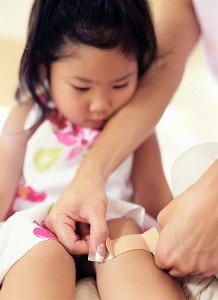
Skin is an elastic covering. It protects you against exposure to dangerous things in the environment such as bacteria. It also repels water, minimizes water loss from the body and protects underlying structures such as blood vessels, nerves and organs.
The material posted on this page is for information purposes only. If you want to learn to recognize and manage major or minor skin injuries enrol in St Mark James first aid and CPR training.
FACTS ABOUT SKIN:
- • Regulates body temperature.
- • Stores water and fat.
- • Is a sensory organ.
- • Prevents water loss.
- • Prevents entry of bacteria.
- • Immunologic surveillance
- • Thermo-regulation
- • Control of insensible fluid loss.
PARTS OF THE SKIN
- • Epidermis – the outer or the first part of the skin. That consist of: Stratum corneum (horny layer) Keratinocytes (squamous cells) (Basal layer).
- • Dermis – it is the middle layer or the second part of the skin. The dermis contains the following:
- • Blood vessels
- • Lymph vessels
- • Hair follicles
- • Sweat glands
- • Collagen bundles
- • Fibroblasts
- •Nerves
• Subcutaneous fat layer (subcutis) – The subcutis is the deepest or the third layer of skin. The subcutis consists of a network of collagen and fat cells.
WHAT IS SKIN LACERATION
A laceration is an injury that results in an irregular break in the skin, more commonly referred to as a cut, but defined as a torn and ragged wound. You do not need to see a doctor if the tear does not involve the full thickness of the skin. Most minor lacerations have minimal bleeding, minimal pain and no numbness or tingling at the site. If you can see any bones or tendons or there is excessive bleeding and pain, seek medical attention immediately.
THERE ARE FIVE GENERAL TYPES OF LACERATION
- Split laceration: This type of wound is caused when part of the body is crushed between two objects. While not as serious and a crush injury, a split laceration is caused in the same manner, with the striking object making a blunt impact and causing the skin and tissues to tear from compression. Split lacerations most commonly show up on the face, head, hands and legs.
- Over-stretching: This would is typically caused by a single, angular force that strikes the skin and either pushes or pulls the skin, causing it to stretch and break. An example of an over-stretching wound would be a gunshot. As a bullet pierces the skin at an angle and continues underneath, it will lodge beneath the skin and cause compression and expansion that will tear the skin beyond the initial point of impact.
- Grinding compression: When an object strikes the skin with a blunt impact at either an angle or with a sweeping motion, the resulting laceration is a grinding compression. In the same manner that a potato is peeled, a person’s skin is essentially peeled back when this type of laceration occurs. As the object strikes the skin, the tissue is crushed beneath the epidermis and the top layer of skin peels away.
- Cut laceration: The most common type of laceration, a cut occurs when any type of blade (knife, ax, scissors, etc.) comes into contact with the skin, causing a break of the skin and possibly the underlying tissue.
- Tearing: Just as the name implies, this type of laceration occurs when the skin is broken by an object and the break is ripped due to pressure pushing the wound in two different directions, essentially causing the skin to tear like a piece of paper.
HOW DO YOU TREAT MINOR LACERATIONS?
- • Clean the laceration site well with warm water and an antibacterial soap.
- • Apply an antibiotic ointment such as Bacitracin or Neosporin.
- • Cover the laceration with a Band-Aid or sterile gauze. Change the Band-Aid daily or when soiled. When the dressing is changed, clean the site and reapply the ointment.
If red streaks or drainage appear around the laceration, please contact your primary care physician immediately.
Bruising may be seen around the laceration site which is caused by blood clotting under the skin surface. Some swelling may also be noted at the site. If bruising and swelling occur, you can apply ice to the site and elevate the area above the level of the heart. If the bruising and the swelling do not improve within 24 hours, contact your primary care physician.
An Effective first aid strategy is the ability to deliver treatment. The goal of the person performing first aid is to do what is necessary. First Aid Training may be a small thing for most people but first aid training (register here) may just save your loved one’s or your own life.
Related Video
http://www.youtube.com/watch?v=x17IAot_JNk
